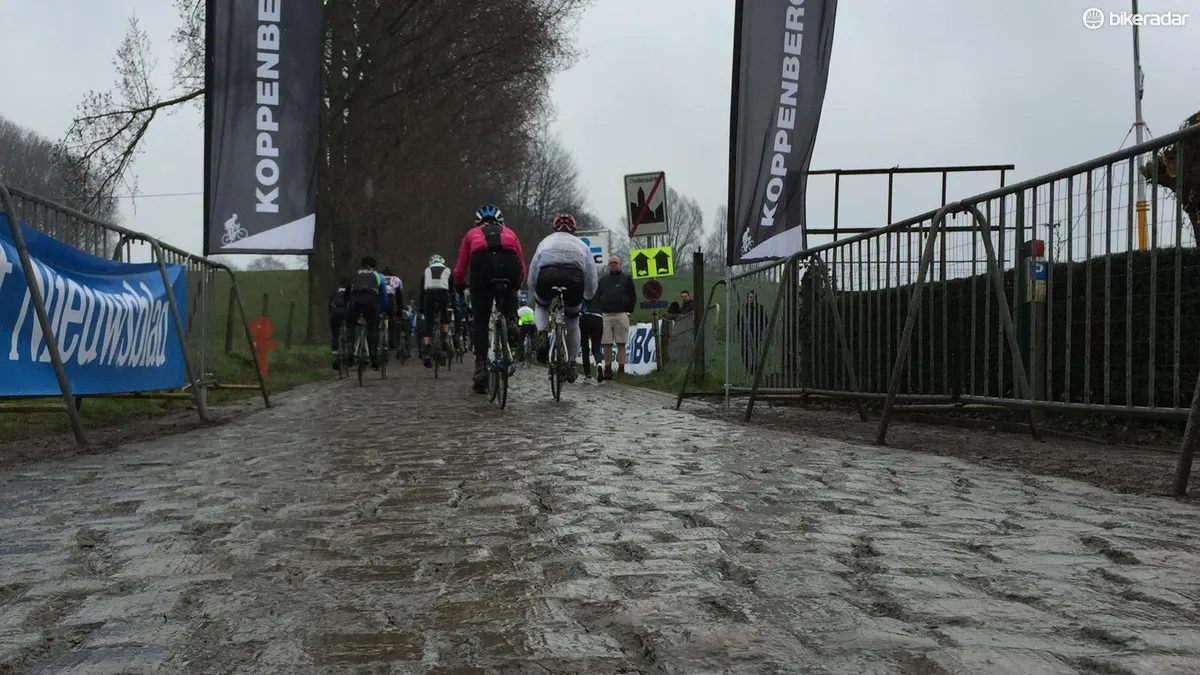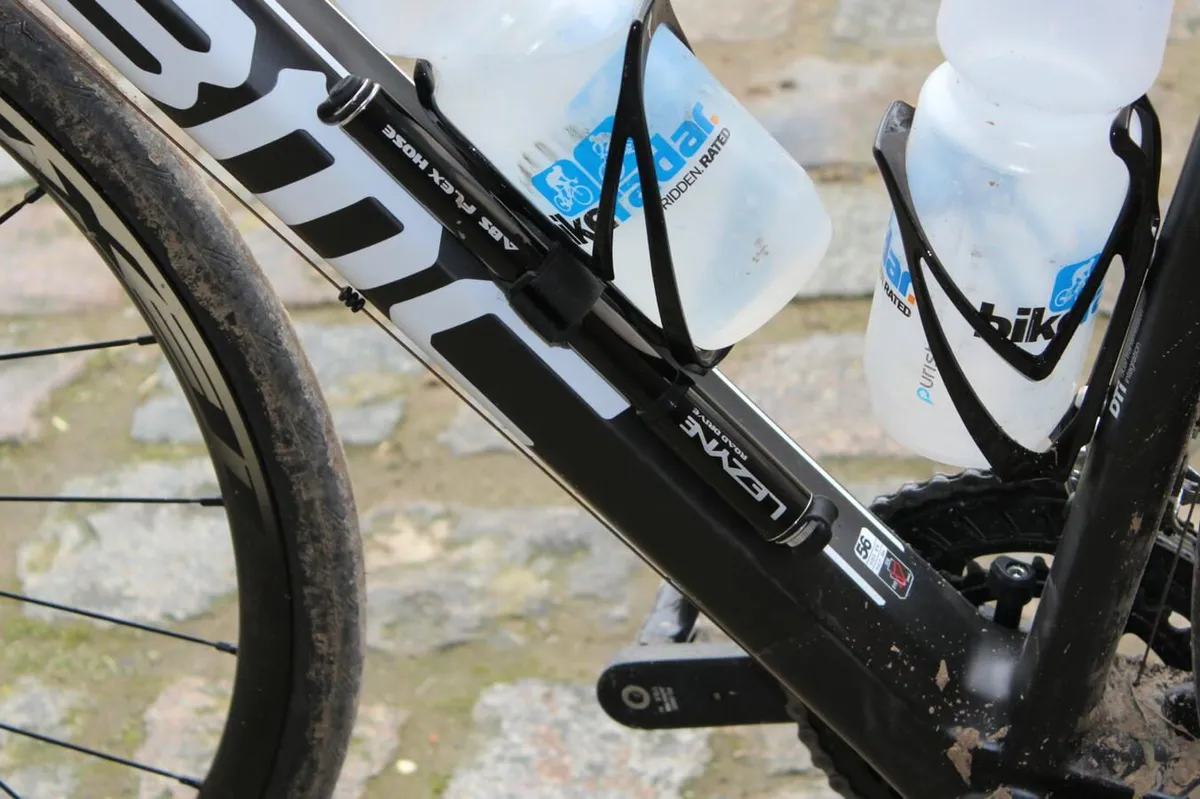Held on and around the course of the Tour of Flanders, the Ronde van Vlaanderen Cyclo sportive boasts more than 16,000 participants. Having done the event three times, this year I tackled the wet and muddy cobbles around Oudenaarde, Belgium on a BMC GranFondo GF01 105, with hydraulic disc brakes, plush 28mm Continental Ultra Sport clinchers and crazy-low gearing of 50/34 and 11-32.
As with many gran fondos, the Ronde offers three distances: the full 239km from Bruge to Oudenaare, the short 71km loop that still tackles famed cobbled climbs such as Koppenberg, Kwaremont and Paterberg, and the Goldilocks middle distance of 123km that I’ve done in years past.
Although Flanders cobbles pale in comparison to the brutal stones of Paris-Roubaix, some similarities apply. For one, going faster is better; the slower you go, the more energy the old rocks suck out of you.
So why the mountain-bike-style low gear? Two reasons. One, I’m old. And two, traversing up farm-mud-slick cobbled climbs that kick to 22 percent with 16,000 of your closest friends isn’t always the most expedient way to go up.
If you want to ride the climbs, you simply cannot count on having a clean run at it, as riders are constantly spinning out, running out of power, putting a foot – or sometimes the entire bike and body – down on the stones in front of you.

- The course: De Ronde van Vlaanderen Cyclo sportive (127km distance) with 16, mostly cobbled climbs and nine additional cobbled sectors
- The equipment goal: A comfortable setup for the cobbles, with a somewhat racy position and gear appropriate for climbing 22-percent cobbled pitches in traffic. No flats!
- The horse: A BMC GranFondo GF01 105 Disc, completely stock plus Shimano Ultegra pedals, Garmin Edge 1000, K-Edge XL Mount
Contemplating a five- to six-hour day with a grim rain pouring down, I was frankly more concerned about clothing than bike gearing with temps around 4C/39F at the start. Having been miserable too many times before, I erred on the side of over-preparation. In retrospect, I can heartily endorse the following: the plastic Aeroshell (read: rain cover) on my Lazer Z1, Castelli’s Tempesta Pocket Jacket with hyper-breathable eVent fabric (think GoreTex), Castelli Gabba jersey and Nanoflex warmers, Pearl Izumi's P.R.O. Barrier WxB shoe covers, Bontrager long sleeve wool baselayer and Capo ISO Neoprene gloves. I wasn't cold all day, and I didn't overheat with the Tempesta Jacket on all day, even when going 170bpm up the steeps.
As with the professional race held on Sunday, the amateur event on Saturday tackles all manner of tiny goat roads weaving through farms and up and down cobbled lanes. Riding in Belgium, if you've never done it, is wonderful. Imagine paved singletrack for roadies, twisting and undulating and scaring and delighting every few km.
This year I did the Ronde with four friends. Following the flow of literally thousands of riders, we managed to miss the turn for the middle route and ended up doing the short version, which still had us out for more than four hours with food and photo stops. It also put us in the heart of the people when tackling the mighty Koppenberg, the party-central Kwaremont and the often-decisive Paterberg. With each still soaked from rain and mud sliding off the earthen hills bracketing the climbs, each proved a challenge, especially with scores of others slipping, sliding and stumbling on foot up the bergs.

Most riders are forced to walk on cobbled climbs like the Paterberg. Having low gearing is a huge advantage
Luckily, the amiable Belgians ride like they drive, with courtesy. Although a lack of traction and/or power would force most riders on the Cyclo to their feet on the three cobbled climbs mentioned above, they would clear the center line with the sound of a "hup!" from behind. On the Koppenberg, I followed my friend Zach up through the walking crowd. A few riders crashing meant we had to nearly trackstand a couple of times, but the 34/32 meant I could continue creeping up without dabbing. I had a similar experience on the Paterberg on my friend Caley's wheel. Slippery mud on cobbles would certainly have had me on foot on with standard gearing, but the near 1-to-1 ratio kept me upright and moving forward.
On the flat and downhill stretches of cobbles, the GranFondo proved a steady steed. Whether it was the fat, 28mm Continental clinchers, the heavily kinked frame design, the carbon lay-up, the flexy seatpost or some combination thereof, the bike flowed over the cobbles with an absolute minimum of fuss.
Braking was always a one-finger affair, even on oh-man-I'm-coming-in-too-hot sharp corners. I was able to drop fast into corners (later than my friends with carbon hoops) without worry.
I have two minor gripes with the 105 bike. One, the internal routing is cool, but the front hydro line comes up through the top headset spacer, which forces the handlebar position higher than I'd like. And two, the stock Shimano RX31 wheels are heavy. But all in, the bike is phenomenal.
Make no mistake, riding cobbles is a – literally – rattling affair, no matter what you're riding. But having missed out on the middle distance Saturday, I was eager and still fresh enough to get back out two days later and ride the target distance. The bike again delivered: no dabs with the gearing (a few of my buddies with 28s had to walk the Koppenberg), no flats with the Continentals, and no out-of-the-ordinary post-ride soreness with the smooth-riding BMC GranFondo GF01 Disc.
If you can ever get over to Belgium to ride the Ronde, do it! And if you want a great bike for the event, the BMC GranFondo GF01 Disc is an excellent horse for the course.
Click through the gallery above for a closer look at the bike.





















